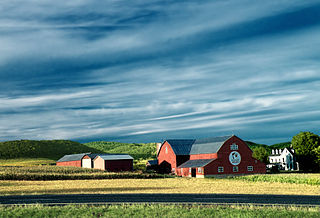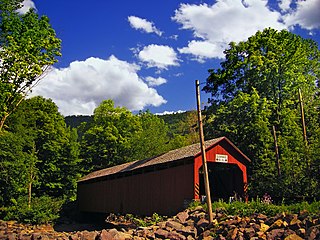
Lycoming County is a county in the U.S. Commonwealth of Pennsylvania. As of the 2010 census, the population was 116,111. Its county seat is Williamsport.

Muncy is a borough in Lycoming County, Pennsylvania, United States. The name Muncy comes from the Munsee Indians who once lived in the area. The population was 2,477 at the 2010 census. It is part of the Williamsport, Pennsylvania Metropolitan Statistical Area. Muncy is located on the West Branch Susquehanna River, just south of the confluence of Muncy Creek with the river.

Muncy Township is a township in Lycoming County, Pennsylvania, United States. The population was 1,089 at the 2010 census. It is part of the Williamsport Metropolitan Statistical Area.

Williamsport is a city in, and the county seat of, Lycoming County, Pennsylvania, United States. It recorded a population of 27,754 at the 2020 Census. It is the principal city of the Williamsport Metropolitan Statistical Area, which has a population of about 114,000. Williamsport is the larger principal city of the Williamsport-Lock Haven, PA Combined Statistical Area, which includes Lycoming and Clinton Counties.

Samuel Sloan was a Philadelphia-based architect and best-selling author of architecture books in the mid-19th century. He specialized in Italianate villas and country houses, churches, and institutional buildings. His most famous building—the octagonal mansion "Longwood" in Natchez, Mississippi—is unfinished; construction was abandoned during the American Civil War.

This is a list of the National Register of Historic Places listings in Lycoming County, Pennsylvania.

The Cogan House Covered Bridge is a Burr arch truss covered bridge over Larrys Creek in Cogan House Township, Lycoming County, in the U.S. state of Pennsylvania. It was built in 1877 and is 94 feet 2 inches (28.7 m) long. The bridge was placed on the National Register of Historic Places in 1980, and had a major restoration in 1998. The Cogan House bridge is named for the township and village of Cogan House, and is also known by at least four other names: Buckhorn, Larrys Creek, Day's, and Plankenhorn.

The Buttonwood Covered Bridge is a covered bridge built in either 1878 or 1898 over Blockhouse Creek in Jackson Township, Lycoming County in the U.S. state of Pennsylvania. It uses a queen post with king post truss and is 74 feet 2 inches (22.6 m) long. The bridge was placed on the National Register of Historic Places in 1980, and had a major restoration in 1998. It is the shortest and most heavily used of the three covered bridges remaining in Lycoming County.

The Lairdsville Covered Bridge is a wooden covered bridge over Little Muncy Creek in Moreland Township, Lycoming County, Pennsylvania in the U.S. state of Pennsylvania. It was built in 1888 and placed on the National Register of Historic Places in 1980.

The Sonestown Covered Bridge is a covered bridge over Muncy Creek in Davidson Township, Sullivan County, Pennsylvania built around 1850. It is 110 ft (34 m) long and was placed on the National Register of Historic Places (NRHP) in 1980. It is named for the nearby unincorporated village of Sonestown in Davidson Township, and is also known as the Davidson Covered Bridge. It was built to provide access to a grist mill which operated until the early 20th century.

The Sullivan County Courthouse is a historic courthouse building in downtown Laporte, Pennsylvania, United States. Built in 1894, this Romanesque Revival courthouse is a rectangular building measuring approximately 92 feet by 60 feet, built of brick with a slate roof. Since its construction, it has been the most prominent building in Sullivan County.

St. James Episcopal Church is a historic Episcopal church in Muncy, Lycoming County, Pennsylvania, United States. It was designed by architect Richard Upjohn in 1856, and built between 1857 and 1859.

The Peter Herdic House is a historic home located at 407 West 4th Street between Elmira and Center Streets in the Millionaire's Row Historic District of Williamsport, Pennsylvania, United States. It was built in 1855–1856, and is a 2+1⁄2-story, brick building, coated in stucco in the Italian Villa style. It features three bay windows on each floor and a distinctive cupola atop the roof. Peter Herdic was a notable figure in the early development of Williamsport, and served as its fourth mayor, beginning in the fall of 1869.

Reading-Halls Station Bridge is a historic Howe pony truss railroad bridge located at Muncy Township, Lycoming County, Pennsylvania. It was built in 1846 by the Philadelphia and Reading Railroad, and is a single-span bridge measuring approximately 70 feet (21 m) long. It is the oldest bridge of its type still in operation in Pennsylvania.

The Jersey Shore Historic District is a national historic district located in Jersey Shore, Lycoming County, Pennsylvania. The district encompasses 286 contributing buildings in the central business district and surrounding residential area of Jersey Shore. Most were built during the period 1830 to 1860, and are representative of Victorian, Greek Revival, and Federal style architecture.

The Millionaire's Row Historic District is a national historic district located at Williamsport, Pennsylvania. The district includes 263 contributing buildings and one contributing site in a residential area of Williamsport. The buildings date as early as 1855, and are representative of Victorian style architecture. Notable non-residential buildings include the Trinity Church and Parish House, First Church of Christ-Scientist, Weightman Block, Park Home, and the Covenant Central Presbyterian Church. Way's Garden is the contributing site and it was established in 1913. Located in the district and separately listed is the Peter Herdic House.

Old Conemaugh Borough Historic District is a national historic district located at Johnstown in Cambria County, Pennsylvania. The district includes 330 contributing buildings in a predominantly working-class residential area in Johnstown. It includes a few examples of high-style Victorian-era dwellings representing the Queen Anne and Second Empire styles. Notable buildings include the Young House, Christian Kakuck House (1888). Spenger House, W. H. Smith Residence, Otto M. Hornick House (1904), American House (1832), Brass Rail Bar, St. Joseph's German Catholic Church (1868), Central Catholic School (1906), and Hudson Street School.

Uptown Somerset Historic District is a national historic district located at Somerset in Somerset County, Pennsylvania. The district includes 190 contributing buildings, 1 contributing site, and 1 contributing object. It encompasses an area centered on the county government complex and Somerset County Courthouse, with the surrounding commercial district, residential areas, and cemetery. Notable buildings include the former Somerset Trust Company Building (1906), First National Bank (1922), County Jail and Sheriff's Residence, Lansberry House (1869), Edward Scull House (1847), former Somerset Academy (1882), Printing House Row (1872), St. Paul's United Church of Christ (1887), IOOF Building (1889), and First Christian Church (1909-1912).

Lansdowne Park Historic District is a national historic district located at Lansdowne, Delaware County, Pennsylvania, USA. The district includes 103 contributing buildings; the majority are residences. Eighty-one of the houses were built between 1889 and 1891, with Queen Anne as the dominant architectural style. The remaining houses were built beterrn 1899 and 1913 and include notable examples of the Dutch Colonial Revival and Georgian Revival styles. The oldest house is the Dickenson Farmstead, a 2½-story dwelling built in 1732 and expanded in 1790. A notable non-residential building located in the district is St. John's Episcopal Church (1901); it closed in 2009.

Kirks Mills Historic District is a national historic district located at Little Britain Township, Lancaster County, Pennsylvania. The district includes 12 contributing buildings in the village of Kirks Mills. They are Jacob Kirk's Mansion House, Brick Mill / Kirk's Mill, the brick miller's house, stone and log barn converted to a residence in 1975, Joseph Reynold's House (1825), Eastland Friend's Meeting and Tenant House, Ephriam B. Lynch House (1880s), Harry Reynolds House, Manuel Reynolds House, Eastland School House (1838), and Log House. The Jacob Kirk's Mansion House is a three-story, brick dwelling with a two-story ell. It features a full porch on the front and right sides. Kirk's Mill is a 2+1⁄2-story brick building with a slate gable roof. It was remodeled to a residence about 1940.
























